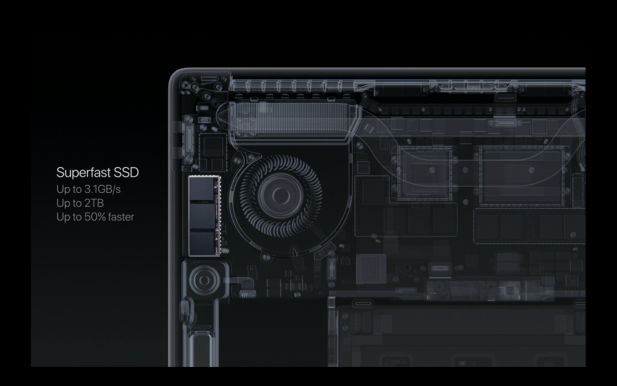Two weeks ago both Apple and Microsoft rolled out their latest iterations on the PC. Microsoft went first with an exciting twist on the all-in-one form factor in the Surface Studio. And Apple followed up shortly with an even thinner version of the MacBook Pro. On the outside Microsoft seems to have the better spec’d hardware with much faster GPUs and slightly faster CPUs. But CPUs and GPUs are not the bottleneck in modern PCs. As years of stagnation have shown a better CPU only has a very limited impact on user experience where the difference is nill for writing, browsing, and shopping.
The User Experience Problem
Where having a better CPU helps in tasks like image rendering or program compilation which 90 percent of users will never do. The impact of a faster GPU on user experience is more pronounced where an upgrade can take games from unplayable to a solid 60 FPS at good quality settings and there’s growing number of content creation applications that support GPU acceleration. But while GPU can make gaming possible and reduce the length of time required to batch process photos or videos thing that take a long time on a CPU more often than not still take a while even when GPU accelerated.
When consumer SSDs first hit the market back in 2009 most people didn’t believe they were a necessary upgrade from conventional hard drives. Until you’ve used a PC with an SSD as its primary storage system and then gone back to using a system with a conventional hard drive it’s difficult to understand just how much a fast storage system improves user experience. Even today, as we sit on the cusp of SSDs achieving price parity with hard drives, there are still people who chose PCs with large hard drives over those with smaller SSDs because they haven’t experienced the difference that an SSD makes.
More generally the biggest levers that Microsoft and Apple have to improve the experience that their products provide are storage, graphics, and general compute in that order. Microsoft spent this cycle addressing graphics and making modest gains in storage and general compute. Apple on the other hand is offer modestly better general compute, a decent gain in graphics, and a massive gain in storage. In this way Microsoft’s products are iterative from a technical perspective while Apple’s will actually provide a meaningfully better user experience compared to their last generation and Microsoft current crop.
Apple Understands The Importance of Storage
Why will Apple’s MacBook Pro provide a better user experience than Microsoft’s offerings? It’s all in the storage system. Not storage volume, that’s been a solved problem for many years now; but storage speed. Not only does Apple have Intel’s Thunderbolt standard to communicate with external storage devices but they’ve also created one of the fastest SSDs in existence at 3.1GB/s. Of course we don’t know if that’s read or write speed for the sake of comparison we’ll assume it’s a measurement of sequential read performance. We’ll have to wait a bit longer for third-party benchmarks but if Apple’s numbers are legitimate then the MacBook Pro has an NVMe PCI-E SSD that is nearly twice as fast as anything that Microsoft is offering. Dongle issues aside, the best Microsoft can do for external storage is USB 3.0 at 5 Gbps while Apple is out in front with Thunderbolt 3 which is eight times as fast at 40 Gbps.
Given that storage speed is the biggest lever for improving user experience at a hardware level it’s clear that Apple’s MacBook Pro will set a new standard for the kind of responsiveness and fluidity that buyers expect in this market segment. I for one can’t wait for Microsoft et al. to catch up when it comes to internal and external storage speed.
For Those Watching At Home
If you’re lucky enough to have a PC with the right kind of M.2 slot then you don’t have to wait for the other OEMs to follow Apple into the present with NVMe PCI-E SSDs thanks to Samsung’s new 960 PRO series of SSDs which offer similar storage performance to Apple’s new MacBook Pro. Of course M.2 support is pretty messy at the moment and the 960 PRO drives are expensive so getting into this level of storage performance isn’t exactly straight forward.
Thunderbolt 3 is another issue entirely, and given that it’s using the USB-C connector it seems inevitable that a newer USB standard will offer comparable speeds at some point in the future. More importantly you only really need USB 3.1 to handle the read/write bandwidth capabilities of most external storage devices. Thus both of items that endow Apple’s MacBook Pro with a superior user experience will likely be picked up by other PC OEMs in the next generation of PCs. For now though Apple is clearly in the lead and fast storage is the spear of that focus on user experience.S|A
Thomas Ryan
Latest posts by Thomas Ryan (see all)
- Intel’s Core i7-8700K: A Review - Oct 5, 2017
- Raijintek’s Thetis Window: A Case Review - Sep 28, 2017
- Intel’s Core i9-7980XE: A Review - Sep 25, 2017
- AMD’s Ryzen Pro and Ryzen Threadripper 1900X Come to Market - Aug 31, 2017
- Intel’s Core i9-7900X: A Review - Aug 24, 2017
